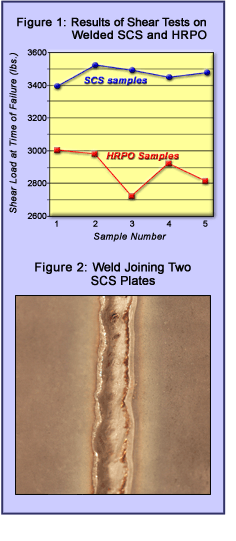| As fabricators gain experience welding SCS we hear good news about improved weld quality, savings on consumables and, of course, a decrease in hazardous welding fumes versus welding P&O (August 2004 SCS UPDATE). However, we sometimes learn of a new user having problems with excess weld spatter when welding SCS. Studies show that small changes in shielding gas and filler wire feed eliminate excess spatter and yield greater savings on consumables. This article gives the basis of the SCS advantages and explains welding practices that let fabricators enjoy those advantages while avoiding the excess spatter. | |||||||||||||
 |
Consistently Stronger Welds In 2003, ten similar samples of welded SCS and hot roll P&O sheets were tested to failure in shear at St. Louis Testing Laboratories. It took an average 580 pounds higher shear load to cause failure in welded SCS samples than the HRPO samples (Figure 1). In all cases, failure of the SCS samples was not at the weld, but in the base steel itself. All HRPO samples failed at the weld nugget. The SCS advantage comes from higher weld integrity. A certain amount of the weld arc’s energy goes to burning the oil on HRPO sheets. This introduces even more contaminants to a HRPO surface that is already fairly ‘dirty’ compared to SCS. The net result is to reduce the integrity of HRPO welds compared to SCS welds. User experience gained since the 2003 tests reinforces this finding. That Matter of Excess Spatter Most fabricators who switched to SCS reported cleaner, stronger welds with really no spatter. Figure 2 shows a typical such SCS weld sample. However, a few reported unacceptable levels of spatter. To find the cause, TMW enlisted the help of the Illinois Manufacturing Extension Center which provides technical services to manufacturers. IMEC’s project manager, Steve Bosworth, teamed up with Optimum Engineering Solutions, Inc. to conduct controlled welding tests of SCS. First, they replicated the welding practices of fabricators who reported excess spatter and saw similarly unacceptable results They next studied changes in shielding gas composition and filler wire feed rate (click for details). Changing from 90%Argon-10%CO2 to 95%Argon-5%Oxygen improved arc stability and drastically reduced spatter. Lowering wire feed speed worked very well with the new gas recipe. In fact, using ER70S-6 filler wire at a slower feed speed with the Argon-Oxygen mix provided notably better penetration and improved bead appearance when welding at the same speed. |
||||||||||||
| Greater Savings on Consumables The study revealed that the best parameters for welding SCS (or P&O for that matter) were different from what these fabricators had been using. A change to the optimized shielding gas/filler wire combination not only ensures superior SCS welding performance, it also yields savings on consumables! The gas supplier for the study sells the new Argon-Oxygen mix at 5% less than the Argon-CO2 mix. But bigger savings are realized on filler wire. The more uniform weld bead you get with optimized SCS parameters means less filler material for a given weld joint. Couple that with a reduced wire feed rate for the same welding speed, and the savings in welding wire can reach 30%. We’ll gladly send SCS samples for you to do your own welding tests, plus the shear strength and spatter test reports. And we've developed guidelines for optimized GTAW welding of SCS. IMEC’s Bosworth explains that the guidelines reinforce methods that the AWS, ESAB and others prescribe, so welders should use, them in general, not just for SCS. Contact your SCS supplier to obtain your copy prior to welding SCS for the first time. |
|||||||||||||
